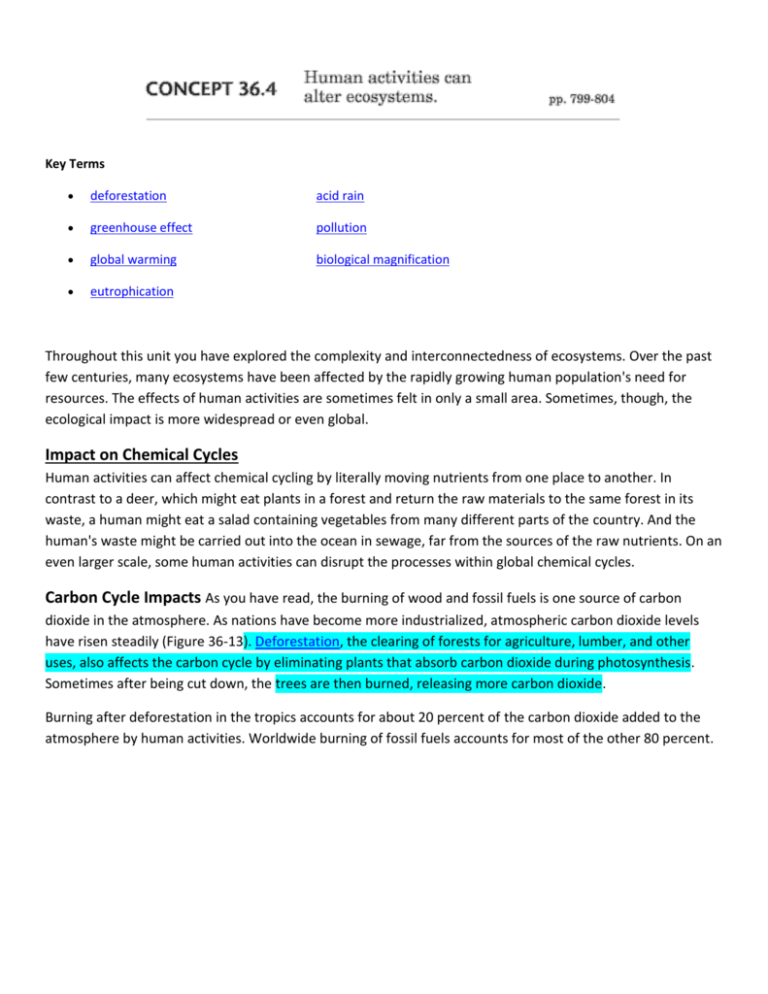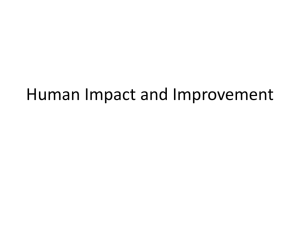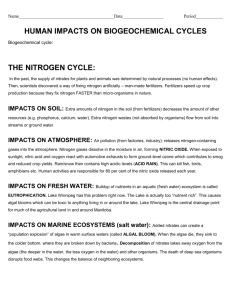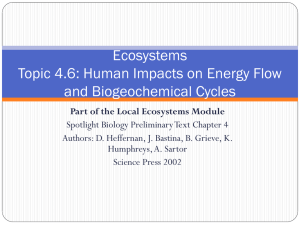Impact on Chemical Cycles
advertisement

Key Terms deforestation acid rain greenhouse effect pollution global warming biological magnification eutrophication Throughout this unit you have explored the complexity and interconnectedness of ecosystems. Over the past few centuries, many ecosystems have been affected by the rapidly growing human population's need for resources. The effects of human activities are sometimes felt in only a small area. Sometimes, though, the ecological impact is more widespread or even global. Impact on Chemical Cycles Human activities can affect chemical cycling by literally moving nutrients from one place to another. In contrast to a deer, which might eat plants in a forest and return the raw materials to the same forest in its waste, a human might eat a salad containing vegetables from many different parts of the country. And the human's waste might be carried out into the ocean in sewage, far from the sources of the raw nutrients. On an even larger scale, some human activities can disrupt the processes within global chemical cycles. Carbon Cycle Impacts As you have read, the burning of wood and fossil fuels is one source of carbon dioxide in the atmosphere. As nations have become more industrialized, atmospheric carbon dioxide levels have risen steadily (Figure 36-13). Deforestation, the clearing of forests for agriculture, lumber, and other uses, also affects the carbon cycle by eliminating plants that absorb carbon dioxide during photosynthesis. Sometimes after being cut down, the trees are then burned, releasing more carbon dioxide. Burning after deforestation in the tropics accounts for about 20 percent of the carbon dioxide added to the atmosphere by human activities. Worldwide burning of fossil fuels accounts for most of the other 80 percent. Figure 36-13 The zig-zag shape of this graph is due to seasonal changes in atmospheric levels of carbon dioxide. Levels decrease each year during the summer growing season and increase during the winter. The overall level of carbon dioxide has climbed during the last four decades. How are increased carbon dioxide levels in the atmosphere significant? Carbon dioxide is one of a few gases in the atmosphere that allow sunlight to pass through to Earth, but trap some heat as it is reflected and radiated from Earth's surface (Figure 36-14). As a result, the temperature of Earth's surface is higher than it would be if all heat escaped into space. These gases act somewhat like the glass windows of a greenhouse that allow light in, but prevent heat from escaping. Because of this analogy, the process by which atmospheric gases trap heat is called the greenhouse effect. As the levels of carbon dioxide and other "greenhouse gases" rise, the greenhouse effect becomes stronger, trapping more heat in the atmosphere and raising Earth's average temperature. Such an overall rise in Earth's average temperature is called global warming. Figure 36-14 The greenhouse effect is a natural process that stops all of the sun's heat from escaping rapidly back to space. This process can be altered by human activities that affect the levels of greenhouse gases in the atmosphere. Using a variety of computer models, scientists make predictions about the long-term effects of increasing carbon dioxide levels. Global warming predictions range from just tenths of a degree to a few degrees Celsius. Scientists also have different hypotheses about the possible effects of global warming. For example, a few degrees of warming could cause enough melting of glaciers and polar ice caps to cause a rise in sea levels, flooding low-lying coastal areas. Small changes in temperatures could also have large effects on weather, such as changing precipitation patterns. The boundaries between biomes might shift, affecting the species that live in them. Which species could move or adapt quickly enough to survive these changes? The answer is unknown. International cooperation and individual actions are all needed to lessen the chance of these outcomes. Nations can identify ways that people in the tropics can support themselves without burning forests. Nations can also reduce use of fossil fuels by conserving energy and developing alternative energy sources, such as wind, solar, and geothermal energy. You can help by making your home more energy-efficient and by walking, biking, or riding public transportation. Nitrogen Cycle Impacts Human activities impact the nitrogen cycle primarily by moving large amounts of nitrogen compounds into the water or the air. For example, some sewage treatment plants release dissolved nitrogen compounds into streams and rivers. Fertilizers applied to crops are another source of nitrogen compounds—excess fertilizer may run off into nearby streams and ponds. The high levels of nitrogen, often along with phosphates, feed the rapid growth of algae in these bodies of water, a condition called eutrophication. As the algae die, the bacteria decomposing them can use up so much of the oxygen in the water that there is no longer enough to support other organisms. Smokestacks and automobile exhaust pipes release certain nitrogen and sulfur compounds into the atmosphere. There these compounds combine with water, forming nitric and sulfuric acids. Precipitation that carries this acid back to Earth's surface is called acid rain. The Clean Air Act has helped lessen the acid rain problem in the United States by reducing levels of sulfuric acids. However, precipitation in some areas is still acidic enough to cause damage. Water Cycle Impacts One human activity that can impact the water cycle is deforestation. A primary way that fresh water returns to the atmosphere is transpiration from dense tropical forests. As a result, tropical deforestation greatly reduces the amount of water vapor added to the atmosphere. This changes precipitation patterns and affects ecosystems. Drawing water from rivers or underground aquifers for household use or crop irrigation also affects the water cycle. If the rate of water use is faster than the rate at which the water cycle can replace it, the river or aquifer may eventually run dry. Other Effects of Pollution The addition of substances to the environment that result in a negative effect is called pollution. You have just read how pollution can affect chemical cycles. Two more examples show how pollution can affect food chains and Earth's atmosphere. Biological Magnification As organisms take in nutrients and water from the environment, they may also take in pollutants. Though some pollutants may be excreted, others accumulate in an organism's tissues. For example, a group of chemicals called PCBs are soluble in lipids and collect in the fatty tissues of animals. PCBs that are disposed in industrial wastes can remain in the environment for a long time. In the Great Lakes, studies detected PCBs in the tissues of organisms throughout the food web. As higher trophic levels fed on each other, the PCBs accumulated in each predator's fatty tissues at even higher concentrations. As you can see in Figure 36-17, the concentration of PCBs increased from 0.025 parts per million (ppm) in phytoplankton to 124 ppm in herring gull eggs. The process by which pollutants become more concentrated in successive trophic levels of a food web is called biological magnification. Figure 36-17 In this Great Lakes food chain, the concentration of PCBs measured in herring gull eggs was almost 5000 times higher than that measured in phytoplankton. The concentration increased at each successive trophic level. One of the first studied examples of biological magnification involved the pesticide DDT. Before 1971, DDT was used in the United States to control mosquitoes and agricultural pests. As with PCBs, DDT concentrates in fats and becomes magnified at each step of the food chain. When ecologists studying a decline in the populations of top-level consumers such as pelicans, ospreys, and eagles found high levels of DDT in the birds' eggs, they realized that DDT was a serious environmental problem. DDT caused the birds' egg shells to be easily breakable, thus fewer young survived to hatch. When DDT was banned in the United States, populations of these birds made a dramatic recovery. Concept Check 36.4 (on separate paper, or sent to nyoshuff@gmail.com) 1. Describe how increased quantities of carbon dioxide in the atmosphere may contribute to global warming. 2. Give an example showing how pollution relates to biological magnification. 3. How can deforestation impact the carbon and water cycles? 4. Define each of the underlined terms found in Concept 36.4.








